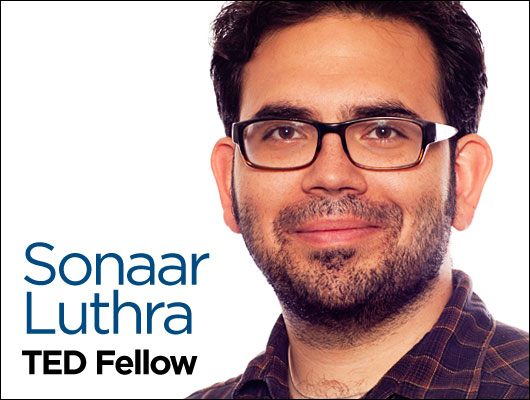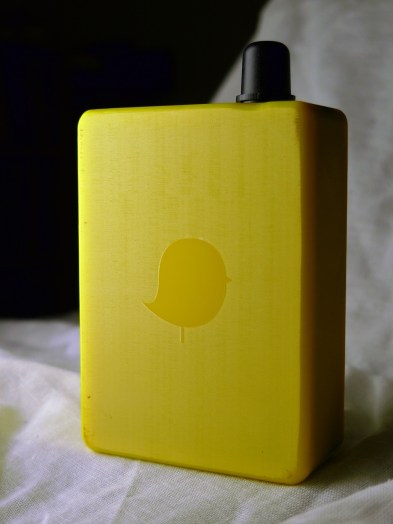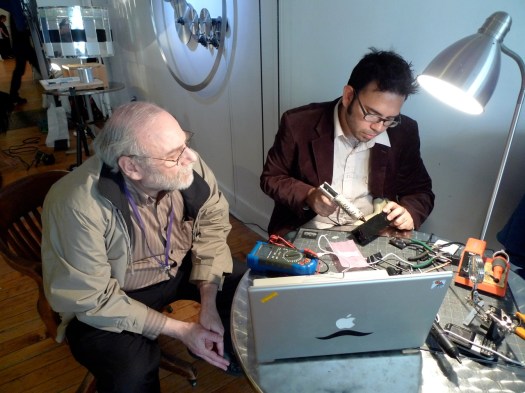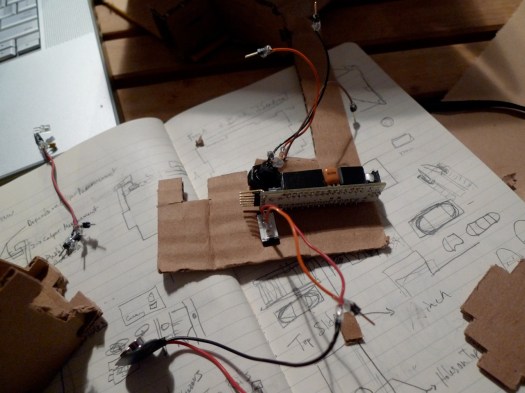
You have a background as a writer, educator and journalist. How did you end up creating the Water Canary?
I went to NYU’s Interactive Telecommunications Program (ITP) because I realized that so many of the social outcomes I was after as an educator and journalist could be better accomplished by designing better tools. I wanted to come up with some way of becoming what I was calling an “urban planner for the global village.” At that point, I was thinking about tools that could transform classrooms, but it was really a bigger vision than that.
I fell in love with circuitry and with making tangible objects that had real functionality. Next thing I knew, I found myself in a class called Design for UNICEF, taught by Clay Shirky in association with UNICEF’s Innovations Lab. We were looking at ways to leverage technology and telecommunications strategies to transform the work that UNICEF does in the field. This was just as things like Ushahidi (an open source project that lets users crowdsource crisis information via mobile) were beginning to gain traction. People were just starting to realize the potential of leveraging mobile phones. I was interested in other ways we might design social interventions that relied on simple but important pieces of information. I wanted to see what was possible with water, and I was lucky to have an incredible team and the support of faculty that were willing to take on such a huge challenge. We started off as novices but we all became water experts in the process.
Why water?
My parents immigrated to Minnesota, but I used to spend summers in Delhi when I was a kid and worked there as a journalist, so it’s like home to me. I grew up seeing my grandfather getting up every morning at 5am to boil water, but not understanding why. I always found water safety confusing.
When I dug deeper, every document I read inevitably acknowledged that, even with the Millennium Development Goals, there was a complete lack of information about water. We had some information about water scarcity and depleting freshwater supplies, but almost nothing about water quality. I wondered, “What would happen if you knew whether your water was safe or not? What would that knowledge do in a city like New Delhi?” You can’t really excuse the lack of safe water there. It’s no longer a money issue. I decided it was really a matter of there being not enough demand for infrastructure — maybe if people had more information we could transform that.
So the idea behind the Water Canary was an inexpensive gadget that could instantly tell you whether your water was safe or not with a red light or green light, so you don’t have to be literate to use it. Over time, it occurred to us that what we really had was something that could transform disaster response with real-time information. This was right around the time when the Haiti earthquake happened. In emergencies, the assumption that every aid organization has to make is that all water is unsafe. And that leads to the entire response being completely inefficient. They never really know where help is needed. So it means you end up sending too many supplies to places that don’t need them, and that there’s never enough in areas that do.
It started out as a very simple device just for testing whether or not there was a high concentration of bacteria in the water, but that has expanded into detecting nutrient pollution and volatile chemicals as well as microbiological contaminants.
How did you acquire the knowledge to create this device?
I worked very closely with a faculty member at NYU named Eric Rosenthal, who is kind of a genius in optics. He had never done anything with water. When I told him the idea, he told me he’d been working on a technology that might be able to do it affordably and generously taught me everything I needed to make it. It’s changed a lot over the years, but I still work very closely with Eric and he’s now the senior scientist at the company.
And how does the Water Canary actually work?
Right now, generally, if you’re going to test water, you use a chemical reaction that can take up to a day in an incubator. It’s very difficult to carry out for anyone who’s not extremely well trained, and almost impossible in a chaotic situation. The Water Canary uses spectral analysis — essentially shining light through a water sample and measuring what it absorbs — to form conclusions about what’s in the water. It’s fast and uses a microprocessor, so the raw data is captured in the unit, making it easy to transmit in real time. The GPS-tagged data can then be instantly transmitted, so that water safety information can instantly be shared with the world. This makes it possible to quickly identify and respond to hazards — protecting people and the environment and preventing full-scale disasters. Every other effort to link mobile phones to water testing has involved someone entering it into an application. The moment you introduce that step, it’s far less likely that the data will ever be shared, or accurate.
The data gathered will also help build an overall picture of world water health. When you’re distributing inexpensive and accurate devices to people all over the world and collecting lots of data, you’re setting up a system that could get better and better with every reading that you take. We’re starting off the way the weather service started — just as a system for predicting storms. Before we could predict storms, we had no agriculture security, we had food shortages. It was commonplace to lose ships at sea. So just having advanced warning of a storm was enough to transform the world we lived in.
Likewise, if we implement a system that very rapidly identifies a source of water contamination in real time, that in and of itself is extremely valuable. We’re not there yet, but once we’ve collected enough data, we’ll be able to go back even to legacy data and say, “Three years ago, there was benzene in this water.”
How has your business and distribution model evolved?
We originally thought our business would be to sell devices, instead we realized that an open source device and networked data provide us with a much better business model, as well as a way of building a community for sharing water quality information.
What next?
We’re getting the device ready for field testing, raising money to get there, and doing everything necessary to build the best device and community we can.
Who do you picture having Water Canaries? Relief and aid workers? Your grandfather?
I think about Water Canary devices the same way I think of flashlights and smoke detectors: they’re for everyone. Since they’re easy to use and affordable, I don’t see any reason why everyone shouldn’t have them. It’s clear that the most immediate need is for groups like water-testing professionals, scientists, NGOs, municipalities, and people that face unsafe water conditions every day, but that doesn’t mean that it won’t be something everyone eventually owns and uses. The way we designed the technology, it could just as easily be a handheld unit as something installed at the tap, or something you plug into an Android phone.
How does the Water Canary empower people?
It gives people knowledge and a chance to form their own conclusions. Instead of just telling people to use sanitation supplies, you’d make them available and let people make up their own minds whether or not to use them. It also gives people a means to investigate the world around them, and to have a say in what data goes into decisions that impact their quality of life. There’s a huge opportunity to engage ordinary people to collect scientific data to solve problems like this. Citizen science isn’t all that different from citizen journalism: all you need is the simple tool, like a cameraphone, that enables them to report on conditions they identify. In the end I think scientific instruments are just another form of information technology, like computers, and shifts like this become possible when we have the right tools.
Tell us about your experience of being a TED Fellow.
I’ve made incredible connections, both personally and professionally. Water Canary has formed relationships with people from so many fields and disciplines who care about water, the environment and human rights, and want us to succeed. That’s allowed us to put a lot of care into finding the right people to work with and laying a solid foundation for everything we’re going to accomplish in the next few years.
On the most basic level, it’s amazing to participate in a community that collectively has the potential to do almost anything. With so many of the Fellows, it’s not a matter of whether we’ll do something incredible together, but a matter of when. That’s a huge source of motivation because it takes away so much of the isolation you learn to expect when you’re trying to do something impossible.
There are many aspiring social entrepreneurs out there who are trying to take their passion and ideas to the next level. What one piece of advice would you give them, based on your own experience and successes?
I always come back to a William Blake quote: “If the fool would persist in folly he would become wise.” If you’re doing something worthwhile, chances are you don’t know what you’re doing and nobody can tell you the right way to do it. That will always be true, so it’s nothing to be ashamed of and it’s never a good excuse to give up. Committing to your idea means being willing to make a fool out of yourself in the process, and if you can embrace that you’ll come out on the other side with nothing to regret.



Comments (7)
Pingback: » Green shoots for censors, civic science and infrastructure monitoring
Pingback: The Water Canary – A Revolution in Water Contamination « The S.P.A.C.E Program
Pingback: Meet the Water Canary – A major and inexpensive leap in Water Safety protection « The 1000yr Old Man